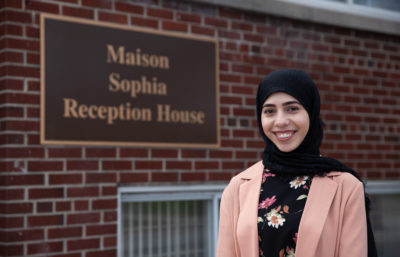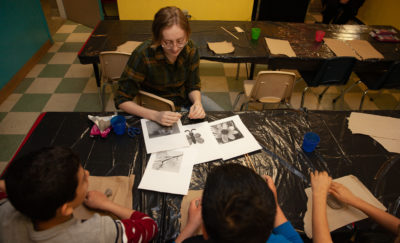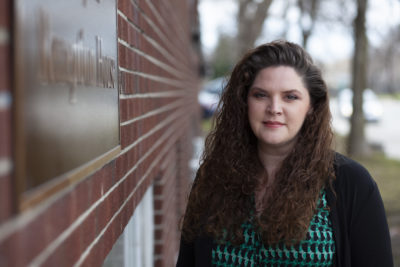Students Making A Difference in the Newly Revamped Program in Childhood and Youth Studies
Quite amazingly, new Canadians represent about 25% of Ottawa’s population.
This statistic speaks not only to the capital city’s rich diversity, but also to Canada’s national aspiration to be a welcoming landing spot for immigrants in search of a life free of violence, hunger, and political turmoil.
The adaptation process can be complex for brand new Canadians who have typically just completed a draining intercontinental journey. Thankfully, there are federally funded programs such as Maison Sophia Reception House, which have the mandate of providing support to our future neighbours upon arriving in Canada.

Established in 1988 and holding up to 96 people, Sophia House offers temporary accommodation of 3-4 weeks for government-sponsored refugees and refugee claimants.
In addition to offering boarding services, Sophia House also provides residents workshops on food, transportation, internet access, housing, emotional support services, and life generally in Canada. This important programming intends to guide people through the challenging transition to a new community and culture by getting them on their feet and self-sufficient.
Importantly, Sophia House also offers a specialized Transitional Learning for Children program for newcomer kids. This program is taught by staff facilitators who help equip the children with the foundational knowledge required to smoothly adapt to their new homes.
Two of the facilitators provided to help child residents are Faten al-Athari and Calla Tait – Carleton students participating in a practicum for the freshly revised Childhood and Youth Studies program (formerly titled, “Child Studies”).
Faten al-Athari

al-Athari first conducted her practicum two years ago at Sophia House and following this voluntary placement, has since been hired to stay on in a full-time position at the reception house.
“During my practicum, I was in charge of leading the classroom activities. Most of the time I was left alone in the classroom with the children,” says al-Athari, who flourished through the challenge of working within the fast-paced environment of families constantly arriving and moving on from the Sophia House.
“I really enjoy working with newcomer children by introducing them to their new environment. Helping them adjust is my favourite part of this job.”
al-Athari herself immigrated to Canada at the age of 10, so she intimately understands the feelings and considerations of a child arriving in a new country. “I can still vividly remember my experience and am very grateful to my first teachers who helped me adjust to my new life. They made me feel accepted, and I would like to do the same for these children as my teachers did for me.”
The Children’s Program accepts children from 6-17 years old, meaning facilitators are required to always be prepared with activities suitable for a diversity of ages – another area in which al-Athari excelled. Her skill and nimbleness, honed by Childhood and Youth Studies did not go unnoticed. Soon after her placement had wrapped and she had completed her degree, al-Athari was offered a one-year contract as a Children’s Program Worker, a position which looks likely to evolve into a future career.
Calla Tait

As fate would have it, one of al-Athari’s first duties in her new capacity was to supervise another Childhood and Youth Studies student, Calla Tait. Tait began their practicum at Sophia House under al-Athari’s supervision in the winter of 2019.
“Faten was so helpful in making me feel comfortable at the Children’s Program,” says Tait. “She had been in my shoes, and so she knew which things were difficult and nerve-wracking from her practicum experience. This made it so easy to approach her and ask questions!”
Following in al-Athari’s footsteps, Tait worked with children of all ages who speak a variety of languages from all different backgrounds and experiences. To accommodate this vibrant mix of culture, Tait spent a lot of time doing prep work, researching engaging activities for the children and learning how to communicate with gesture and drawing in the absence of shared language.
“The sheer diversity of the children served as a challenging, but inspiring lesson on how to be flexible, think quickly on my feet, and communicate effectively and compassionately with kids, even if we didn’t speak the same language. These were skills which I refined in Childhood and Youth Studies.”
“I hope that I was able to help them half as much as they helped me,” says Tait.
Professor Patterson

The empowering and life-altering experience of working with immigrant children at Sophia House as part of al-Athari and Tait’s degrees in Childhood and Youth Studies was facilitated in large part by Professor Monica Eileen Patterson of The Institute of Interdisciplinary Studies (host department of the Childhood and Youth Studies program). Although on paper al-Athari and Tait don’t appear very similar, Patterson saw many important commonalities between the two students. “Faten and Calla come from different backgrounds and have had different experiences, but they shared a maturity and commitment to helping children that was quickly revealed when I spoke to them about their interests. They were both enthusiastic about the opportunity and flourished in their positions at the Sophia House,” she says.
Patterson was delighted to watch her students blossom in their roles at Sophia House as they carved their own identities as versatile professionals passionate about teaching and working with children.
The sheer diversity of the children served as a challenging, but inspiring lesson on how to be flexible, think quickly on my feet, and communicate effectively and compassionately with kids, even if we didn’t speak the same language. These were skills which I refined in Childhood and Youth Studies.
“They both told me that one of the most important lessons they learned was to always do the art project yourself before attempting to teach it to others because even with clear instructions, you need to go through the process of doing the exercise firsthand to be able to effectively transfer that knowledge to others.”
“This is a great metaphor for the value of the practicum itself, particularly the way that experiential learning can provide a deeper and different understanding, through learning by doing, that text-based descriptions and analysis cannot,” says Patterson.

Service-Learning in Community Settings: The Practicum in Childhood and Youth Studies
The idea to hold placements at Sophia House was a concept conceived by Child Studies alumnus, Selam Abebe explains Patterson. “When I first started teaching the practicum, almost all of the students took placements in early childhood centres or schools, but I was interested in broadening the range of options based on students’ interests. I had learned of the Sophia House from former Child Studies student Selam, who had volunteered there and whose sister worked there.” Through this connection, Patterson was able to place al-Athari in Sophia House for 2016.
The success of al-Athari and Tait at Sophia House was influential in helping Patterson, and Child Studies Director Professor Julie Garlen make the decision to establish a specific practicum course beginning in the fall of 2019 titled Service-Learning in Community Settings. The course will feature year-long practicum placements at different sites across Ottawa and the surrounding area. Along with a placement, the course also includes readings, class meetings, and essay assignments all designed to enhance understanding and promote critical reflection. “First and foremost, through their placement in a host institution or organization, students have a chance to test out and apply their academic knowledge in a real-world, policy- or practice-oriented worksetting,” explains Patterson.
During their practicum placements, students work in a volunteer capacity under the mentorship of an on-site supervisor with the foremost goals of learning through experience and expanding their networks beyond the Carleton community.
“The course is designed to help students connect theory and practice through six hours per week of field placement in a community setting,” says Patterson. “They will be placed in professional settings, including childcare centres, schools, camps, after-school, extra-curricular, and sports programs, and government and non-profit organizations that serve children and/or youth.”
In these environments, students will be exposed to professional demands that will provide them with invaluable real-life experiences that will enhance their employability and interpersonal skills, helping them develop their own unique professional identity, and transitioning them into the workforce as smoothly as possible. In fact, many practicum students are offered extended, paid jobs as a result of their initial placements.
“Perhaps most importantly, the practicum helps students test out their ideas about themselves and what they think they like and want to do in the future. For instance, many Childhood and Youth Studies students who want to work with children think they have an age group they prefer. But they can never know what their preferences really are until spending time with actual children!” says Patterson.
“Some students are surprised to learn that they prefer working with older or younger ages as a result of their practicum, which is very useful information to have before starting teacher’s college or beginning work in an Early Childhood Educator position. Sometimes learning what you don’t like is even more valuable than finding things you do.”
Childhood and Youth Studies Revised
The emphasis on practicum placement and experiential learning is but one feature of the significantly revised program in Childhood and Youth Studies.
The redesign aims to address the sustained growth of student demand over the last five years and align the program with current trends in childhood and youth studies to position Carleton University as a unique site for innovative research about and with children and young people. It was also renamed and restructured to reflect current developments in the field. Remarkably, since 2012, the program has seen a 765% increase in enrolment from 66 students, to 505 in 2018.
With this program change, Carleton positions itself as one of the few pioneering universities around the world where critical child and youth scholars from a wide range of disciplines have been brought together in one academic unit. This shortlist also includes Rutgers University-Camden in the U.S., Brock University in Southwest Ontario, and Linköping University in Sweden.
As explained by Patterson, the program has also evolved to reflect current epistemological and methodological trends in critical childhood and youth studies, which remains a relatively new and hastily growing field within the contemporary academy. “The field of critical childhood and youth studies is premised on a departure from traditional psychological and sociological approaches to conducting research ‘on’ children, which limits the agency, voice, and participation of young people,” she says.
“Contemporary critical childhood and youth scholars believe that children themselves are the best informants on their own lives and therefore take children’s own cultures, meanings, and worldviews seriously. We also see children as important, active members of society who impact the world and those around them in multiple and profound ways.”
“While traditional research has viewed children as passive, dependent, or incomplete, critical scholars view young people as vital participants in society, differently competent to adults, but of interest for what they are now, not only what they will become.”
Universities have much to offer society as sites of learning and critical thinking, not only by providing insight into current issues through theory, research, and critical analysis. But for this insight to be relevant, it must be connected to the lived experiences of real people
With their reconfigured study focus and enhanced opportunities for distinctive practicum placements, Childhood and Youth Studies develops resilient graduates ready for a wide range of professional and academic careers in schools, hospitals, community and governmental agencies, or universities.
The implemented changes in Childhood and Youth Studies reflect what Patterson believes should be the role of the university in 2019.
“Universities have much to offer society as sites of learning and critical thinking, not only by providing insight into current issues through theory, research, and critical analysis. But for this insight to be relevant, it must be connected to the lived experiences of real people,” she says.
“For me, experiential learning is such a crucial component of one’s education as it allows for theory and practice to test one another. Engaging in community service, activism, and protest enables students to see themselves as active citizen-scholars in a global world, and not just passive recipients of knowledge. Such engagement leads both students and faculty to be contributing members of their society, and to develop a more holistic and empowered sense of themselves as social agents.”
Unsurprisingly, when discussing their time in Childhood and Youth Studies, Tait echoes Patterson’s beliefs.
“My favourite thing about Childhood and Youth Studies was how many doors it opens, and how you can go so many different directions with it. This is exciting but also makes it a bit complicated when trying to think about post-university options. Because of this, I really value my hands-on experience, since, in my mind, it is the best way to learn how to work with children and different types of career possibilities.”
“I can’t express how happy I am to be in this program,” declares Tait.
For more information about Childhood and Youth Studies, please visit: https://carleton.ca/iis/programs-of-study/child-studies/